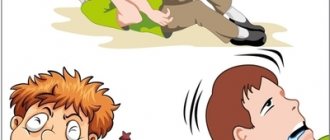Asthenia is a symptom of the underlying disease, but there is also a syndrome. There are several types depending on your cause, but in almost all cases the symptoms can be resolved if proper treatment is given.
A person who has asthenia may experience the following symptoms:
- lack of energy;
- fatigue;
- physical exhaustion;
- mental exhaustion;
- muscle weakness;
- impaired concentration;
- decreased vitality;
- sleep disorders.
What is asthenic syndrome
Asthenic syndrome in adults
may have the following characteristics:
- First of all, it is an indicator of fatigue and overstrain. In the case of hard work, several jobs, or having to overwork, working at night, then in the morning there is a feeling of fatigue, weakness, decreased mood, sensitivity to smells and bright lighting, decreased endurance to usual stress, the appearance of headaches or exacerbation of migraines. This condition usually goes away after proper sleep and rest, excluding external stimuli.
- The reaction of the nervous system is of the “protective” type. This is a process that was inherent in our body during the process of evolution, helping to protect our mental processes from reboot due to the influence of various external and internal factors. It is based on the extreme inhibition reflex. This mechanism is triggered upon the occurrence of asthenia, when a threat to the body arises. An example is when a student is preparing for an exam and tries to study the materials for the entire semester on the last evening, then absent-mindedness, decreased concentration, headache, etc. occur. Thus, asthenia occurs as a defensive reaction notifying the body of a possible threat.
- Diseases. An asthenic state
also occurs with the development of certain diseases of the cardiovascular, endocrine systems, oncopathology, mental disorders, etc.
For example, the first stages of the disease with acute viral infections are indicative, when weakness, fatigue, drowsiness and irritability occur even before the body temperature rises and other characteristic symptoms appear. For some conditions, on the contrary, only signs of asthenia : hypertensive crisis, mild concussion, recovery from anesthesia. Most diseases still begin with asthenia and continue with the development of other symptoms. And during recovery, asthenia is still possible. Asthenic disorder
in adult women often accompanies premenstrual syndrome.
From all of the above, we can conclude that often asthenia, what it is, symptoms in women
, occurs due to overwork or somatic pathology. And it arises due to the reaction of the nervous system. In this case, asthenia is a state of reboot, and asthenic syndrome is a disease.
symptoms of asthenia
Chronic asthenia syndrome.
Chronic asthenia can be defined as a feeling of fatigue that is constant, has an evolution of more than six months and leads to a significant decrease in efficiency of up to 50%. In such cases, consultation with a doctor is necessary.
Although in many cases an organic or psychological cause for chronic asthenia can be found, in a large percentage of patients a specific cause cannot be determined.
The most common symptoms of chronic asthenia are:
- Feeling very tired.
- Headache.
- Sleep disorders.
- Muscle pain.
- In some cases, fever. They look like flu symptoms, only they are long-lasting and are not relieved by bed rest.
When a cause cannot be determined, doctors believe that symptoms may be caused by changes in the immune system or muscle cell function, but these are actually theories that have not yet been proven.
Most cases of chronic asthenia appear in previously healthy people between the ages of 20 and 50, and more often affect women than men.
What does it mean that chronic asthenia has an irregular evolution?
In about half of patients, symptoms disappear after several months of treatment, while others suffer relapses. In these cases, symptoms come and go, worsening when you experience physical or psychological stress.
Sometimes the feeling of fatigue and weakness is so great that it interferes with daily activities, and this can cause anxiety and depression.
Imagine that for several months you feel extremely tired, your muscles and headaches hurt, and after a long period of rest the symptoms reappear. Anyone will feel depressed in this situation.
Characteristic symptoms
Asthenia symptoms
: feeling of fatigue, malaise, and fatigue persists even after rest. Problems with concentration, absent-mindedness, difficulties in learning new material, forgetfulness, the essence of thinking and communication is easily lost, increased sensitivity and tearfulness.
Light and photophobia, hypersensitivity to sounds, smell and taste. Sleep disturbance (drowsiness during the day, poor quality of sleep at night, difficulty falling asleep, or, conversely, unusually long sleep duration).
Headaches and dizziness also occur.
Characterized by the appearance of intolerance to stuffy space, fluctuations in pulse, blood pressure, sweating, shortness of breath.
Increased feeling of anxiety.
Unpleasant sensations in different parts of the body.
Classification
Currently, there is no generally accepted classification of asthenic syndrome in medicine. Doctors use a classification in their work that is based on the reasons for the development of this condition. Taking this into account, the following types of asthenia are distinguished:
- Reactive (functional) – develops as a protective or compensatory reaction. It can occur in healthy people under the influence of opportunistic factors. These could be a change of job, place of residence, vitamin deficiency , long-distance flights, competitions, etc. This condition can be provoked by activities in which there is constant tension in the adaptation mechanisms. We are talking about such mechanisms as disturbances in the wakefulness and sleep patterns of those who work shifts, and emotional stress in people of certain professions. Also, reactive asthenic syndrome can be observed in those who have suffered serious illnesses, injuries, surgeries and are undergoing a recovery period. In the modern world, functional asthenia often develops in people whose profession requires either increased attention or provokes constant emotional stress. An important feature of this type of disease is reversibility. It is always associated with a provoking factor.
- Primary or functional is an independent disease that includes psychogenic and constitutional disorders. Patients, as a rule, are low weight, tall, suffer from heart disease, hypotension, and very poorly tolerate any stress. Symptoms of asthenia appear against the background of any psychogenic influences.
- Secondary is a symptom caused by somatic and mental illnesses. Asthenic syndrome manifests itself in infectious, cardiac, endocrine, mental, oncological and other diseases. This condition may be associated with taking certain medications, as well as harmful effects (radiation, toxic substances, etc.).
Depending on how long the symptoms last, acute and chronic forms of the disease are distinguished.
- Acute asthenia , as a rule, is functional in nature.
- Chronic – lasts a long time. This type includes chronic fatigue syndrome and alcoholic asthenia.
According to the characteristics of clinical manifestations, the following forms of the disease are distinguished:
- Hyposthenic - with this type, susceptibility to external stimuli decreases, the person remains almost constantly sleepy and tired.
- Hypersthenic – there is increased excitability, the patient is irritable, does not perceive bright light and loud sounds well.
In addition, the following forms of the disease are distinguished separately:
- Neurasthenia is a consequence of exhaustion of the nervous system.
- Neurocirculatory asthenia is a complex of dysfunctions of the autonomic system that affects the functions of the body as a whole. The neurocirculatory form manifests itself with symptoms similar to those of heart disease.
- Senile asthenia is typical for older people who need constant care.
- Cerebroasthenia – has a neurotic origin. The condition is characterized by cerebral circulatory failure. As a result, cerebrovascular disease is manifested by headaches, dizziness , weakened memory, and a feeling of exhaustion.
What to do if asthenia occurs?
First of all, it is necessary to exclude all external stimuli. In most cases, this is the most effective method of eliminating asthenic manifestations
.
If asthenia is a manifestation of a pathological process in the body, then additional consultation with a doctor will be required to detect abnormalities in the body, conduct diagnostics, obtain reliable data on the state of health and prescribe the necessary treatment.
asthenic syndrome signs
Causes
The development of somatogenic asthenia may be associated with the influence of the following factors:
- A variety of diseases - infectious, somatic, oncological, hematological, neurological, etc.
- Metabolic and endocrine disorders.
- Syndrome of adaptation disorders.
- Taking a number of medications.
- Occupational exposure.
- Mental illnesses - depression , schizophrenia .
Organic asthenic disorder can develop in people who have suffered a serious brain disease - stroke , trauma, tumor process, as well as in patients with epilepsy . Organic asthenic disorder can be a consequence of anesthesia , poisoning with alcohol or narcotic substances, etc.
The development of reactive asthenia develops in healthy people under the influence of a number of the following factors:
- Past somatic illnesses - myocardial infarction , severe operations, childbirth.
- Excessive stress in older people.
- Seasonal vitamin deficiencies .
- Significant mental overload, excessive stress in athletes.
- The need to be under constant emotional stress in the workplace (dispatchers, translators).
- Constant disturbance of sleep and wakefulness due to shift work.
Often people with an excessive sense of responsibility experience professional overload for a long time. As a result, they develop asthenic syndrome.
Treatment of asthenic syndrome
Treatment of asthenia symptoms
complex and aimed at eliminating the causes and restoring the functions of the nervous system. The following methods are used:
- Elimination of external irritants.
- Drug treatment.
- Application of psychotherapy for asthenic syndrome.
- Physiotherapeutic methods.
- Diet and balanced nutrition.
- Massage and physical therapy.
Timely diagnosis and treatment of this condition are the main factors in maintaining mental health, and at the same time physical and social functions of a person.
Drug treatment of asthenia
Drug therapy is of greatest importance in the treatment of asthenia or astheno-neurotic syndrome. Exhaustion requires additional third-party support, the supply of missing nutrients to the nervous tissue. The list of medications possible for the treatment of asthenia is quite large and requires special attention when prescribing them.
Universal pharmacological methods include neurometabolic therapy (a combination of B vitamins, nootropic, vascular, dehydration and amino acid agents). Neurometabolic therapy, in addition to its pronounced therapeutic effect, is also an effective means of preventing the formation of asthenia. Courses of neurometabolic therapy are used before overload, before upcoming planned stress. For persons whom doctors consider to be at risk for the development of asthenic conditions, courses of neurometabolic therapy are carried out twice a year (usually in spring and autumn). It is not uncommon that, at the doctor’s discretion, only some components of neurometabolic treatment are used, for example, only vitamins or nootropic drugs.
To treat astheno-neurotic syndrome, drugs from the group of neuroleptics, antidepressants and mood stabilizers can be used. They are resorted to in cases where the doctor sees biological changes (disturbances in the neurotransmitter systems of the brain).
Drug treatment of asthenia, like physical therapy, is not a mandatory method of treating asthenic disorders. Only after an in-person examination by a doctor, a decision is made about the need to use pharmaceutical therapy for asthenic conditions. Drug therapy is mandatory in the treatment of asthenia, but it should be moderately reasonable.
Light therapy
Light therapy is used in cases where the symptoms of asthenia and neurotic symptoms are caused by seasonal affective reactions, or when the asthenic disorder is complicated by depressive conditions. During light therapy, the patient is in a special room illuminated by lamps with specially selected characteristics. Light therapy courses can last several tens of days. Light therapy is an optional method of treating asthenoneurotic syndrome.
Treatment of asthenia with rehabilitation programs
Some experts, traditionally, classify rehabilitation therapy for astheno-neurotic syndrome as a type of psychotherapy, however, in this method of treating astheno-neurotic syndrome, in addition to psychotherapeutic mechanisms, sensory receptors (smell, tactile sensations, perception, etc.) begin to work. climatic, physical, social and other factors. Therefore, travel therapy is often recommended for rehabilitation and is even considered a separate method for treating asthenic and neurotic conditions.
Only a doctor has the right to send a person on a trip in an asthenic or astheno-neurotic state, having assessed the benefits and risks of this method in each specific case.
Prevention
To prevent the development of asthenic syndrome, it is necessary to follow some recommendations.
- Establish a normal sleep and wakefulness pattern, resting at least 7 hours at night. It is recommended to wake up at the same time and go to bed at the same time. At night, you can drink soothing mint or lemon balm tea. In the morning – take 20 drops of tincture of ginseng or eleutherococcus.
- While working, regularly take short breaks and perform short exercises for the eyes and improve cerebral circulation.
- Periodically undergo a course of relaxing massage. It will help relieve stress and improve performance.
- Give up bad habits - do not smoke, minimize alcohol consumption.
- Introduce a maximum of healthy and healthy foods into your diet. The last time to eat is no later than 2 hours before bedtime.
- If unpleasant symptoms develop, consult a doctor and undergo the examinations prescribed by him.
Treatment with folk remedies
Some folk remedies can be effective as adjuvant treatment. But before using them, you still need to consult a doctor.
- An infusion of herbs that improves body tone . You should mix equal proportions of St. John's wort, hawthorn and chamomile flowers, pour 1 tsp. of this collection add 200 ml of boiling water and leave for half an hour. Drink before bed.
- Invigorating tea . Mix equal proportions of hop cones, lavender flowers, linden and St. John's wort. 1 tsp. pour a glass of boiling water over the mixture. Drink instead of tea 2 times a day.
- Coffee with herbs . Mix 1 tsp. calendula, hawthorn flowers, rosemary leaves, burdock herb, add 1 tsp. ground coffee. Pour boiling water, leave for an hour, strain. Drink twice a day instead of tea.
- Rubbing in the morning . It must be carried out at a fast pace, using a terry towel or a special mitten. You need to rub the entire body, starting from the cheeks and cheekbones, until the body turns pink. In this case, everything needs to be done quickly - the whole procedure lasts for a minute.
- Bath with lavender . It is recommended to take a bath several times a week, adding lavender oil (6-7 drops) to it. You can also add a decoction of lavender flowers to the water (50 g of raw material per 2 liters of water).
- Infusion of lemongrass . 2 tbsp. l. pour 1 tbsp of lemongrass fruit. boiling water, leave and strain. Drink 10 ml of the product twice a day.
- Eleutherococcus tincture . Pour 200 g of crushed Eleutherococcus roots into 1 liter of vodka. Leave in a dark place for two weeks, shaking occasionally. Take 2 times a day, 30 drops.
- Honey with vinegar . Mix 1 tsp. apple cider vinegar with 1 tbsp. l. honey Use after meals once a day.
- Vegetable juice . It is useful to drink celery, fresh cucumber and beet juices mixed in equal proportions. This drink should be diluted by half with water before consumption. Drink 100 ml twice a day.
Diet
Diet for the nervous system
- Efficacy: therapeutic effect after 2 months
- Timing: constantly
- Cost of food: 1700-1800 rubles per week
Nutrition for asthenia must be complete and varied so that the body receives all the components it needs. It is recommended to eat small meals - 5-6 times a day.
To improve brain activity, it is important to provide the body with the maximum amount of amino acids that help improve brain detail. To do this, it is recommended to include liver, beef, poultry, fish, dairy products, eggs and seafood in the diet. Cereals, seeds, nuts, berries and fruits, and fresh herbs are healthy. For dessert, chocolate, honey, and dried fruits are recommended.
Green tea, decoction of ginkgo biloba leaves, and mint tea are recommended as drinks.
If you have asthenia, it is recommended to exclude the following products from the menu:
- Fried foods.
- Low-fat food.
- Fast food and semi-finished products.
- Spreads.
- Canned food.
- Soda, confectionery.
- Caffeinated drinks (coffee, tea), alcohol.








